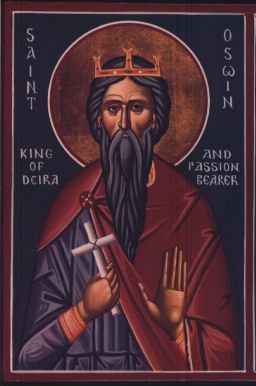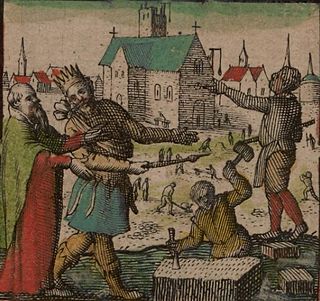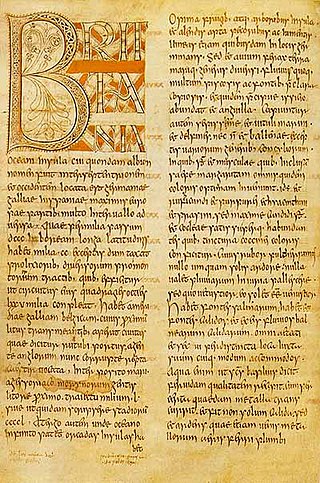
Rowley Burn (also known as Rowley Brook and Ham Burn[ citation needed ], NY 9358) is a stream in Northumberland, running around three miles south of Hexham before joining the Devil's Water, which flows into the River Tyne. [1]

Rowley Burn (also known as Rowley Brook and Ham Burn[ citation needed ], NY 9358) is a stream in Northumberland, running around three miles south of Hexham before joining the Devil's Water, which flows into the River Tyne. [1]
Allen Mawer's Place-Names of Northumberland and Durham implies that the name of the stream may have the same etymology as places called Roughley, from Old English rūh (rough') and lēah ('open land in woodland'). [2]
The formation of the Rowley Burn valley has been discussed by J. B. Sissons. [3]
Bede's Historia ecclesiastica gentis Anglorum , completed around 731, recounts a story of the Battle of Heavenfield, which Bede says took place 'in loco, qui lingua Anglorum Denisesburna, id est Riuus Denisi, uocatur' ('in a place which in the language of the English is called Denisesburna, that is the stream of Denisus' around 634. [4] William Greenwell found evidence in a charter issued for the Archbishop of York by Thomas de Whittington in 1233 that Denisesburna was identical with Rowley Burn, and the identification has been accepted since. [5] Despite Bede's interpretation of the Old English word Denisesburna as meaning 'Denisus's stream', more recent scholarship has judged that the first element more likely comes from the Brittonic languages. [6]

Bretwalda is an Old English word. The first record comes from the late 9th-century Anglo-Saxon Chronicle. It is given to some of the rulers of Anglo-Saxon kingdoms from the 5th century onwards who had achieved overlordship of some or all of the other Anglo-Saxon kingdoms. It is unclear whether the word dates back to the 5th century and was used by the kings themselves or whether it is a later, 9th-century, invention. The term bretwalda also appears in a 10th-century charter of Æthelstan. The literal meaning of the word is disputed and may translate to either 'wide-ruler' or 'Britain-ruler'.
Ecgfrith was the King of Deira from 664 until 670, and then King of Northumbria from 670 until his death in 685. He ruled over Northumbria when it was at the height of its power, but his reign ended with a disastrous defeat at the Battle of Nechtansmere against the Picts of Fortriu in which he lost his life.

Oswine, Oswin or Osuine was a King of Deira in northern England.
The Battle of Degsastan was fought around 603 between king Æthelfrith of Bernicia and the Gaels under Áedán mac Gabrá

Sæberht, Saberht or Sæbert was an Anglo-Saxon King of Essex, in succession of his father King Sledd. He is known as the first East Saxon king to have been converted to Christianity.

Ceolred was King of Mercia from 709 to 716.

The Battle of Heavenfield was fought in 633 or 634 between a Northumbrian army under Oswald of Bernicia and a Welsh army under Cadwallon ap Cadfan of Gwynedd. The battle resulted in a decisive Northumbrian victory. The Annales Cambriae record the battle as Bellum Cantscaul in 631. Bede referred to it as the Battle of Deniseburna near Hefenfelth.
Æthelhere was King of East Anglia from 653 or 654 until his death. He was a member of the ruling Wuffingas dynasty and one of three sons of Eni to rule East Anglia as Christian kings. He was a nephew of Rædwald, who was the first of the Wuffingas of which more than a name is known.

The Ecclesiastical History of the English People, written by Bede in about AD 731, is a history of the Christian Churches in England, and of England generally; its main focus is on the conflict between the pre-Schism Roman Rite and Celtic Christianity. It was composed in Latin, and is believed to have been completed in 731 when Bede was approximately 59 years old. It is considered one of the most important original references on Anglo-Saxon history, and has played a key role in the development of an English national identity.

The Saint Petersburg Bede, formerly known as the Leningrad Bede, is an Anglo-Saxon illuminated manuscript, a near-contemporary version of Bede's 8th century history, the Historia ecclesiastica gentis Anglorum. Although not heavily illuminated, it is famous for containing the earliest historiated initial in European illumination. It is so named because it was taken to the Russian National Library of Saint Petersburg in Russia at the time of the French Revolution, by Peter P. Dubrovsky.
Offa was King of Essex. D. H. Kirby dates his reign as 705 to 709. Simon Keynes dates it c.694 to 709, when he went on a pilgrimage to Rome, where he died as a monk, along with Cenred, King of Mercia. He may have been co-king with Swæfred. He was the son of Sighere, who had died in about 690.
Wighard was a medieval Archbishop-elect of Canterbury. What little is known about him comes from 8th-century writer Bede, but inconsistencies between various works have led to confusion about the exact circumstances of Wighard's election and whether he was ever confirmed in that office. What is clear is that he died in Rome after travelling there for confirmation by the papacy of his elevation to the archbishopric. His death allowed Pope Vitalian to select the next archbishop from amongst the clergy in Rome.
The Battle of Chester was a major victory for the Anglo-Saxons over the native Britons near the city of Chester, England in the early 7th century. Æthelfrith of Northumbria annihilated a combined force from the Welsh kingdoms of Powys and Rhôs, and possibly from Mercia as well. It resulted in the deaths of Welsh leaders Selyf Sarffgadau of Powys and Cadwal Crysban of Rhôs. Circumstantial evidence suggests that King Iago of Gwynedd may have also been killed. Other sources state the battle may have been in 613 or even as early as 607 or 605 AD.
Romanus was the second bishop of Rochester and presumably was a member of the Gregorian mission sent to Kent to Christianize the Anglo-Saxons from their native Anglo-Saxon paganism. Romanus was consecrated bishop around 624 and died before 627 by drowning. Little is known of his life beyond these facts.
Bede may refer to

Eadhæd was a medieval Bishop of Lindsey and sole Bishop of Ripon in the Medieval era.
Hartlepool Abbey, also known as Heretu Abbey, Hereteu Abbey, Heorthu Abbey or Herutey Abbey, was a Northumbrian monastery founded in 640 CE by Hieu, the first of the saintly recluses of Northumbria, and Aidan of Lindisfarne, on the Headland Estate of Hartlepool now called the Heugh or Old Hartlepool, in County Durham, England.

Cædmon's Hymn is a short Old English poem attributed to Cædmon, a supposedly illiterate and unmusical cow-herder who was, according to the Northumbrian monk Bede, miraculously empowered to sing in honour of God the Creator. The poem is Cædmon's only known composition.
Michael Lapidge, FBA is a scholar in the field of Medieval Latin literature, particularly that composed in Anglo-Saxon England during the period 600–1100 AD; he is an emeritus Fellow of Clare College, Cambridge, a Fellow of the British Academy, and winner of the 2009 Sir Israel Gollancz Prize.
John Smith (1659–1715) was an English cleric, known for his edition of the Historia ecclesiastica gentis Anglorum of Bede.
Coordinates: 54°55′22″N2°05′04″W / 54.92273°N 2.08432°W